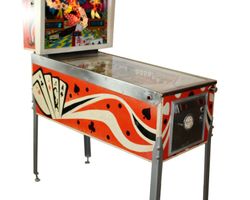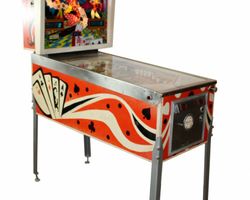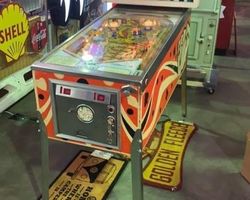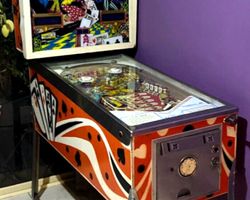Joker Poker
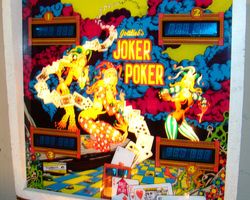
Average Prices: USD $300 to $2,500
Produced: June, 1978
Production Run: 9,280 units
Machine Type: Solid State Electronic
MPU: Gottlieb System 1
Players: 4
Design by: Ed Krynski
Art by: Gordon Morison
D. Gottlieb & Co. released "Joker Poker" in June 1978, a solid-state electronic pinball machine that quickly established its place in the era's competitive landscape. Designed by Ed Krynski with art by Gordon Morison, this machine emerged during a transitional period for pinball, as manufacturers shifted from electro-mechanical (EM) systems to more advanced solid-state (SS) technology. Notably, Gottlieb simultaneously released an EM version of "Joker Poker" in 1978, a testament to their strategy of catering to both traditionalists and those embracing new electronic advancements. This dual release highlights Gottlieb's confidence in the game's core design and its appeal across different technological preferences. With 9,280 units produced—3,911 for domestic markets and 5,369 for export—"Joker Poker" achieved a substantial production run, indicating its popularity and widespread distribution. It stands as a prominent example from Gottlieb's System 1 generation of machines, a platform that defined much of their output in the late 1970s. The game’s theme, centered around cards and the casino aesthetic, permeates its visual design, inviting players into a world of chance and skill.
Signature Features and Design
"Joker Poker" distinguishes itself through a blend of engaging mechanical elements and cohesive artistic direction. The machine’s primary draw lies in its extensive array of fifteen drop targets, distributed across five distinct banks: two banks of three targets, one bank of five targets, and one bank of four targets. This abundance of drop targets defines the gameplay experience, offering numerous strategic opportunities for players. A notable detail is that the "10" and "J" drop targets are reset by the same coil, a subtle design choice influencing shot strategy. Beyond the targets, the machine features a conventional setup of two pop bumpers, a single slingshot, and a solitary standup target, all contributing to the ball's movement and scoring possibilities.
Gordon Morison’s artwork for "Joker Poker" is a central component of its appeal. The backglass, in particular, is frequently highlighted for its classic, vibrant, and engaging style, featuring attractive women alongside the card-themed visuals. This art style imbues the machine with a timeless charm that resonates with many players. On the playfield, Morison’s hand is evident in the bold colors and clear iconography that complement the game’s theme. While the backglass and playfield art are celebrated, some observers note the cabinet art is more understated by comparison. Adding to the machine's distinct character are Gottlieb’s traditional chime units. Even as a solid-state game, "Joker Poker" retains these electro-mechanical chimes, delivering a nostalgic auditory experience that stands apart from the electronic sounds characteristic of later solid-state machines. This choice provides an "old-school" sound, enhancing the gameplay with satisfying, tangible feedback.
Playfield and Mechanics
The "Joker Poker" playfield layout is a testament to thoughtful design, creating a playing experience that is both accessible and challenging. The overall arrangement is frequently praised for its strategic use of space, promoting diverse shot opportunities. The asymmetrical slingshots contribute to unpredictable ball returns, demanding player adaptability and precise flipper work. At the core of the playfield are the numerous drop target banks, strategically positioned to encourage varied shot angles. Players must navigate these targets to advance their score, making precision a key skill. The 5-bank of drop targets typically anchors the center, serving as a primary objective, while the 3-bank and 4-bank targets are positioned to require different approaches. A single standup target offers a quick scoring opportunity or can be integrated into a larger scoring strategy.
The machine features three flippers, with the third flipper positioned in the upper playfield. This upper flipper allows for specific, advanced shots, expanding the range of scoring options and adding a layer of complexity for skilled players. While some players find this upper flipper challenging to master, its presence contributes to the playfield’s depth. The flow of the game is largely dictated by the pursuit of these drop targets. Successfully clearing banks contributes to bonus multipliers, driving players to methodically aim for specific sections of the playfield. The clear, bold artwork on the playfield, combined with the machine's lighting, ensures that targets and scoring opportunities are well-defined, guiding player focus and contributing to the overall immersion in the card-themed aesthetic.
Gameplay Dynamics
"Joker Poker" features gameplay mechanics centered on its extensive drop target system and a progressive scoring structure. The primary objective revolves around clearing specific banks of drop targets to build a 5x bonus multiplier, a central component of high-score chases. The game’s design encourages a methodical approach: each ball offers a distinct scoring objective, often requiring players to work towards clearing different sets of targets to maximize their score and bonus potential. This progressive difficulty, ball by ball, fosters a compelling loop of engagement.
The rules are straightforward, making the game approachable for new players, yet achieving consistent high scores demands significant skill, accuracy, and nudging ability. For instance, successfully clearing a 5-bank of drop targets not only rewards points but also sets the stage for accumulating a substantial bonus at the end of the ball. The "10" and "J" drop targets, linked to a single reset coil, add a subtle layer of tactical decision-making, as hitting one often influences the state of the other. The machine supports both 3-ball and 5-ball play, with many enthusiasts preferring the 5-ball setting, as it allows for a more complete experience, enabling players to fully explore the game's progression and bonus objectives. While the upper flipper can be challenging, mastering its specific shots for clearing certain targets or activating features can significantly contribute to overall strategy and score. The game’s emphasis on direct, accurate shooting rewards a player’s precision, making it a "shooter's game" in the classic sense.
Reception and Legacy
"Joker Poker" has garnered a largely positive reception within the pinball community, consistently described as engaging, enjoyable, and a prime example of its era. Its most celebrated attribute is its "drop target heaven" design, with the fifteen targets providing a satisfying experience for players who enjoy precision shooting and target accumulation. The addictive core gameplay loop, focused on clearing drop target banks to achieve a 5x bonus multiplier, is a key factor in its enduring appeal, prompting many to play "just one more game." Gordon Morison's artwork, particularly the backglass, is often singled out for its classic appeal, vibrant colors, and thematic coherence, contributing significantly to the machine's character. The inclusion of Gottlieb's traditional chime unit, even in a solid-state machine, evokes a sense of nostalgia for many players, providing an authentic, old-school sound that enhances the experience.
Despite its strengths, some minor criticisms exist. The cabinet art is occasionally noted as being less dynamic than the playfield and backglass artwork. A few players, primarily those with machines in a home environment, suggest that the game's objectives could become repetitive once mastered, though this is a minority opinion. The upper flipper, while intended to open up new shot opportunities, is sometimes described as awkward or difficult to use effectively by some players, leading to it being underutilized. While the chimes are universally appreciated, the overall sound package beyond the chimes is sometimes considered basic. Furthermore, some players observe that side drains can occur easily, demanding refined nudging skills. A very small fraction of players express a dissenting view, finding the gameplay unengaging or the playfield layout sparse, but this perspective is uncommon.
"Joker Poker" is regarded as one of the standout Gottlieb System 1 games and a significant machine of the late 1970s. Its design effectively merges the feel of an electro-mechanical machine with solid-state reliability, bridging a technological gap in pinball history. Its focus on a clear, engaging drop target objective demonstrated how compelling gameplay could be crafted without relying on overly complex rulesets or advanced features. This design philosophy influenced subsequent machines by highlighting the enduring appeal of fundamental pinball mechanics. "Joker Poker" continues to hold a place in pinball history as a machine that perfected a specific type of gameplay, cementing its reputation as a classic and a testament to Gottlieb's design prowess during a pivotal time for the industry.
Sponsored Links
 Ebay Listings
Ebay Listings
 Auction Results
Auction Results
| Cost | Location | Date |
|---|---|---|
| USD $1,800 |  Missouri, United States Missouri, United States |
26 November, 2024 |
| USD $275 |  Ohio, United States Ohio, United States |
16 November, 2024 |
| USD $2,800 |  Maryland, United States Maryland, United States |
21 February, 2024 |
| USD $4,995 |  Pennsylvania, United States Pennsylvania, United States |
25 November, 2023 |
| USD $2,350 |  Tennessee, United States Tennessee, United States |
23 November, 2023 |
| USD $1,600 |  Virginia, United States Virginia, United States |
25 July, 2023 |
| USD $5,700 |  Maryland, United States Maryland, United States |
06 January, 2023 |
| AUD $3,500 |  Victoria, Australia Victoria, Australia |
17 July, 2022 |
| AUD $4,500 |  Victoria, Australia Victoria, Australia |
10 December, 2021 |
| USD $3,000 |  Wisconsin, United States Wisconsin, United States |
17 November, 2021 |


Private Policy · Search Website · Contact Us
As an eBay Partner, we may earn a commission from qualifying purchases made through links on this site, at no additional cost to you.
All trademarks and copyrighted materials remain property of their respective owners. All other content copyright 2007 - 2025 Pinpedia.

